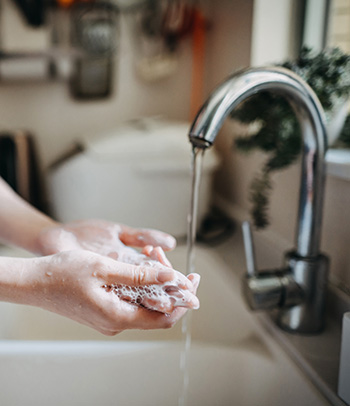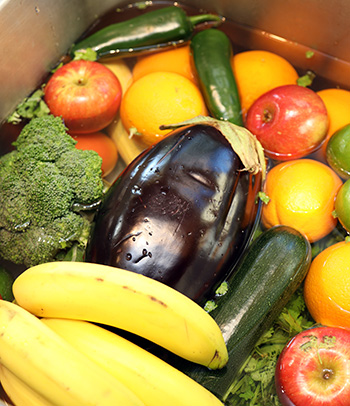Summertime brings longer days, warmer weather and lots of opportunities for outdoor eating!
As foods heat up in the warmer temperatures, bacteria can multiply rapidly.
Picnics, backyard BBQs and cookouts are a great way to relax, enjoy the weather and connect with family and friends. Plates of grilled meats, deviled eggs, chips and dips, and fresh fruits and veggies are part of what makes cookouts so great, but these same foods can cause foodborne illness if you’re not careful. As foods heat up in warmer temperatures, bacteria can multiply rapidly.
Before you plan your next outdoor get-together, check out the following tips and food safety guidelines so you and your guests can stay safe while enjoying the delicious foods of summer.
Food Safety Tips for Outdoor Eating
 Wash your hands before and after handling food. If you’re preparing food, be sure to start with clean hands. Health guidelines recommend washing your hands for at least 20 seconds with warm, soapy water. After you prepare the food, especially if you touch raw meat, wash your hands again thoroughly. Learn more about proper hand-washing with Hand-washing 101: Why It Matters.
Wash your hands before and after handling food. If you’re preparing food, be sure to start with clean hands. Health guidelines recommend washing your hands for at least 20 seconds with warm, soapy water. After you prepare the food, especially if you touch raw meat, wash your hands again thoroughly. Learn more about proper hand-washing with Hand-washing 101: Why It Matters. Wash your produce carefully. Fresh fruits and veggies are perfect for summer picnics, but they can be covered in pesticides. The Environmental Working Group lists the fruits and veggies with the highest traces of pesticides, and it includes summer favorites such as peaches, green beans, cherries and more. Be sure to wash your produce carefully. Use cool running water and rub gently. Even produce with skin, such as melon, should be scrubbed and washed before you cut into it to avoid contaminating the knife and cutting board. Store your cut-up fruits and veggies in the refrigerator until you’re ready to serve them.
Wash your produce carefully. Fresh fruits and veggies are perfect for summer picnics, but they can be covered in pesticides. The Environmental Working Group lists the fruits and veggies with the highest traces of pesticides, and it includes summer favorites such as peaches, green beans, cherries and more. Be sure to wash your produce carefully. Use cool running water and rub gently. Even produce with skin, such as melon, should be scrubbed and washed before you cut into it to avoid contaminating the knife and cutting board. Store your cut-up fruits and veggies in the refrigerator until you’re ready to serve them.- Grill safely. Check out Summer Grilling Season Is Here: How to Make it Safe and Healthy for some great tips on grilling safely, including handling raw meat, keeping it separate from other foods, cooking it thoroughly and more. The U.S. Department of Agriculture has a safe minimum internal temperature chart you can use as a guide while grilling to ensure you and your guests avoid eating undercooked and unsafe meat.
- Use the two-hour rule. The U.S. Food and Drug Administration recommends following the two-hour rule: Discard any perishables left out at room temperature for more than two hours unless you’re keeping it hot or cold. This rule changes to one hour if it’s hotter than 90 degrees. That means you shouldn’t serve or eat food that has been out of the fridge, off the grill or out in the open for more than two hours.
- Keep hot food hot and cold food cold. The U.S. Department of Agriculture warns of a “danger zone” for food temperatures between 40 and 140 degrees. Cold foods should be kept at 40 degrees or colder. Set cold foods on top of ice, place the serving dish or bowl inside another bowl filled with ice, or use cold packs or a cooler. Hot foods should be kept at 140 degrees or warmer, so plan on using chafing dishes, a slow cooker or warming trays to keep things warm. This is critical to preventing foodborne bacteria growth because in-between temps (between 40 and 140 degrees) allow bacteria to multiply quickly.
- Plan your menu for outside weather. Foods like eggs, sour cream, mayonnaise and cheese won’t do well sitting out. Be sure you have a way to keep those foods cold or plan other foods instead, such as fruits you can wait to cut up or peel, dried fruit and nuts for a snack, or a salad that you can wait to dress.
- Keep your food and drinks separate from each other. A cooler full of drinks may be opened more frequently causing cold air to be released and food to warm up accidentally. Keep food in a separate cooler that doesn’t require a lot of opening and closing.
Resources
- FoodSafety.gov offers a collection of resources related to food safety in the summer, including food safety tips for summer gatherings, safe grilling information and much more.
- The Centers for Disease Control and Prevention (CDC) lists several foods that are more likely to cause food poisoning and sickness, like raw or undercooked meat, eggs, fruits, lettuce and more. In addition, the CDC provides information, tips and resources on how to prevent food poisoning.
- The Department of Veterans Affairs (VA) can provide you with some recipe inspiration when you’re planning your next summer cookout. VA’s Garden to Table cookbook is full of fresh, easy recipes and their Healthy Teaching Program has cooking videos, recipes and more.
The next time you’re ready to enjoy a good summer meal outside, remember to do it safely!







